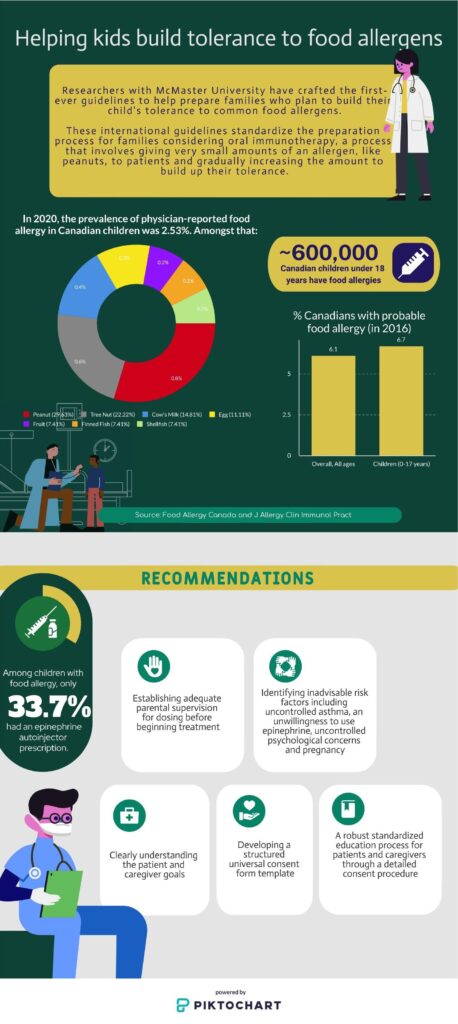Science
New Research Guidelines Can Help Kids Build Resistance to Food Allergies
By Marina Black

On Apr. 8, researchers from McMaster University published the first-ever guidelines to help prepare families who plan to build their child’s tolerance to common food allergens.
The Journal of Allergy and Clinical Immunology published international guidelines outlining a standardized process for families who are considering oral immunotherapy (OIT). This therapy involves gradually giving patients small amounts of an allergen, such as peanuts, and increasing the dose over time to help them build up tolerance.
These new guidelines will help families understand the benefits and risks involved in this therapy. “This is a landmark paper in our field because it has never been done before and this process has never been standardized,” says the paper’s lead author, Douglas Mack to Brighter World.
Some of the benefits of OIT include reducing a child’s risk of reacting or having a severe reaction to accidental exposure to a food allergen, increasing a child’s allergen threshold required to elicit a reaction and improving the quality of life for children and their families.
Food Allergy Canada says food allergies impact three million Canadians, including almost 500,000 children.

Infographic by Saadeq Ahmed
“OIT increases the amount of food a person can eat before they have an allergic reaction. They are still allergic to the food, they just react at a higher amount of food than they did prior to OIT,” says Dr. Julia Upton, a staff immunologist and allergist at SickKids Hospital in Toronto.
However, ingesting small amounts of a food allergen poses risks since it can trigger mild or anaphylaxis reactions in a clinic or at home. Parents, caregivers and children can experience increased anxiety when administering regular food allergen doses at home if protocols are not followed.
“About 20% of people who start OIT stop the therapy due to side effects. Those who are able to continue need to regularly consume the allergenic food for many years or their entire lifetime,” says Upton.
Made with Visme Infographic Maker
Infographic by Katie Bell
“Safety can be optimized to make sure that they understand what they’re taking on, while ensuring that they are aware of the kinds of side-effects that can be dangerous,” says Mack.
“If they decide they want to do it after following these guidelines, they’re prepared for what they’re getting into. They understand the risks and most importantly, it makes it safer because they can anticipate the challenges. This protocol sets the standard moving forward.”
Contact your family doctor or physician if you and your family are interested in starting oral immunotherapy (OIT). For more information on allergies in children and OIT, visit Food Allergy Canada.
Science
A “Cosmic Coincidence”: the Upcoming Solar Eclipse, Explained
A rare appearance of a solar eclipse is ramping up excitement among scientists and Toronto residents. But what, exactly, is happening on Monday? Here’s what you need to know about the spectacular event.

What’s happening on Monday?
On Monday, the moon will block the light of the sun and temporarily darken the sky, causing what’s known as a solar eclipse.
Interactive illustration by Alexa DiFrancesco
But there is no special science behind solar eclipses, according to Nikhil Arora, an astrophysicist at Queen’s University.
“Solar eclipses are cosmic coincidences,” Arora said, that happen whenever the sun, moon and the Earth line up. “It just so happens that we have a moon that is big enough, and just far enough away from us that it can completely cover up the sun for us.”
Solar eclipses happen across the Earth twice a year, according to Sarah Gallagher, a physics and astronomy professor at Western University.
However, “if you’re talking about a specific location on Earth, they’re much less frequent,” she said.
Monday’s eclipse is receiving more attention as it falls over land areas where many people live, Gallagher said.
An almost total eclipse of the heart
In Toronto, the eclipse will begin at 2.05 p.m., and reach maximum coverage at about 3.20 p.m., according to the Royal Astronomical Society of Canada.
Torontonians can expect a partial solar eclipse, as 99 per cent of the sun will be covered, said Hanno Rein, an astrophysics professor at University of Toronto Scarborough.
As one per cent of the sunlight will slip through, the sky won’t go completely dark in Toronto.
The effect will still be dramatic, however, according to Rein. “You can’t really avoid this event… you will notice that it suddenly gets very dark during the middle of the day.”
How and where do I watch the solar eclipse?
Monday’s event has prompted doctors to warn the public against looking at the eclipse without protection, as that can cause permanent eye damage.
Toronto City Council is advising the public to use safety glasses specifically made for eclipse viewing.
It does not matter where you watch the eclipse, as long as you can see the sky, said Gallagher.
“In Toronto, there’s lots of tall buildings, so you have to make sure you’re somewhere where you have a clear view of where the sun is,” she said.
Wildlife enthusiasts may also be interested to check out how animals are behaving during the event.
Some animals behave differently once solar eclipses begin, according to Arora. “If you see bees, as soon as totality hits, these will drop to the ground,” he said. “They think it’s time for bed… If you have chickens or roosters around, they’ll start to prepare for the world’s shortest nap.”
-

 Crime2 years ago
Crime2 years agoToronto’s Massive Car Theft Problem, Explained
-

 Government of Canada2 years ago
Government of Canada2 years agoMaple Leaf Millions
-

 Finance2 years ago
Finance2 years ago“Not like anything we’ve ever seen before”: Reddit group plans Loblaw boycott
-

 Jobs2 years ago
Jobs2 years ago“Shame on Bell”: Unifor stages rally in Ottawa to protest Bell Canada
-

 Canadian Census Data and Trends2 years ago
Canadian Census Data and Trends2 years agoThinking of leaving the province? You wouldn’t be the first
-

 Tax Season2 years ago
Tax Season2 years agoNavigating Tax Season as a University Student
-

 Government of Canada2 years ago
Government of Canada2 years agoNEXUS Prices Set to Rise by Fall 2024
-

 Science2 years ago
Science2 years agoA “Cosmic Coincidence”: the Upcoming Solar Eclipse, Explained


